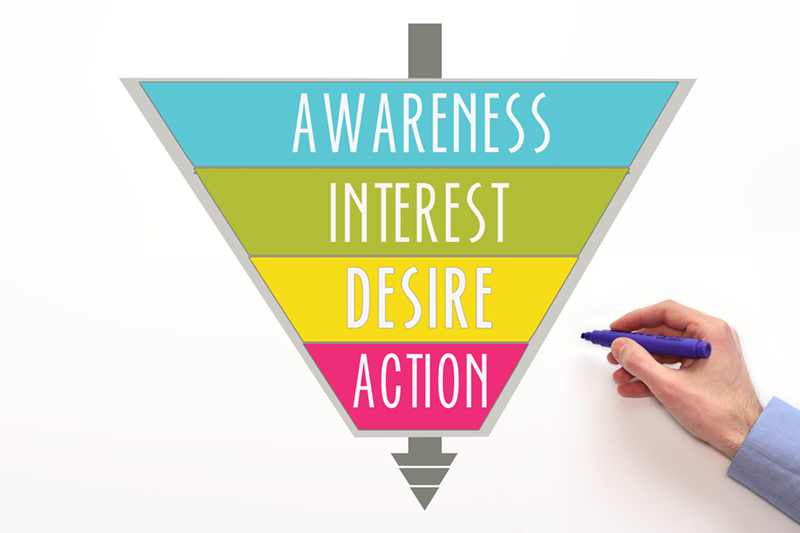Marketing funnels – what are they and why you should care?

Marketing funnels are the sets of steps that a prospective customer needs to go through to progress from discovering your brand to converting into a customer. The length of a funnel (duration or number of steps) depends on a variety of factors, including the process of engaging with a brand, the cost involved with purchase, how well-established and mature the market is and much more.
AIDA explained…
Even if there is a long list of steps involved in conversion, those steps can usually be categorised into a few different stages as per the acronym AIDA described below:
- Awareness/Attention – attracting the attention of the prospective audience whether that is via word of mouth, an online ad, social media or other. Not as simple to get this right as it might first seem – this stage relies heavily on understanding your audience well so that you can be visible where they hang out. It isn’t always obvious where an audience spends their time, so you need to be a detective, using some formal or informal research, to ensure you haven’t made assumptions or overlooked anything.
- Interest – once you have grabbed your audience’s attention, the next part of the funnel is providing information to those that have an interest in finding out more because they have entered a ‘consideration’ mindset. For an audience to connect with your messaging, they need to have recognised their own problem and joined the dots to solving that through the solution you can provide. Sometimes just presenting a solution without explaining what problem is being addressed means that an audience may not have the lightbulb moment of recognising how it applies to them. This is where using copywriting that acknowledges an audience’s pain points is helpful for resonating with them and in turn, provoking their interest in hearing about the solution (in other words; ‘opening the door’).
- Desire – this stage comes after the audience have been convinced by the earlier two stages and has arrived at the point of deciding they would like to take action. It is a critical stage because conversion is practically in your lap by now, but there are some important things you need to do to help conversion stay on track because it is very to inadvertently muck things up at this point (without receiving feedback to learn from)!
Audiences are looking for help to remove any final barriers – this could be anything to do with finances (e.g. offering payment plans, payment with credit card), customer service (e.g. making it as easy as possible, a positive experience), functional (e.g. making sure there are no technical difficulties such as the website being down or not being open when they are available to transact) or other factors. Your job is to understand all these possible barriers from listening to feedback, observing customer behaviour, tracking, analysing and plugging any gaps by innovating and problem solving. It could be as simple as making sure there is enough validation for their decisions on your website (e.g. displaying qualifications/memberships, testimonials and articles) or as complex as needing to diversify your product/service range to cater for a broader range of needs. - Action – this is the final stage and as with the earlier stages there might be multiple steps within it depending on the nature of the purchase. Action could be in the form of a test drive, followed by a finance application before handing over the keys or simply registering their interest. The action you want as the outcome depends on your individual business goals – in some cases, after having completed all four stages of the funnel, the prospective customer will need to go back through the funnel again to take the next action before fully converting and handing over some money!
For example, a prospect may take an initial action to watch a demo of a software product only to decide that it doesn’t meet all their needs and then want to find information about premium level software; ultimately progressing to view a demo of that. Your job at this stage is help make that action as pleasant experience as possible so that whether you receive payment after that or not, the prospects at least remain at the ‘interest’ stage. It's possible that they will not move from the interest to action stage until some point in the future, but if their experience has been a positive one, it is less likely that their attention will be grabbed by a competitor. It makes a difference if they are already well down the funnel because you have continued to nurture and impress them with what you have to offer.
So, what about lead generation, nurturing and selling?
The first stage outlined above, (awareness), is also known as ‘lead generation’. In my experience this is where small businesses put in their biggest marketing efforts and tend to neglect the next three stages. Failing to convert a prospect into a customer can often come down to something so simple and obvious that it can be overlooked.
The next two stages (interest and desire) are also known as ‘lead nurturing’. Education and good communication can play a key role here, however sometimes prospects are left hanging, not sure where or how to find more information, confused by mixed messages and losing that sale can come down to someone not making a follow up call or providing an email with a clear call to action. With all the investment at the lead generation stage, it is such a shame to see the ball being dropped by something that on the surface seems minor but has such value to the prospective customer.
The final stage (action) is also known as ‘sales’, where the final evaluation and purchase happens. Again, even if there has been a mountain of effort involved in the earlier stages, if the prospect customer has a bad experience at this point it can be enough to undermine it all when they walk away. This can even happen if it looks like the left hand doesn’t know what the right is doing (as can be the case when sales and marketing aren’t properly co-ordinated).
Where great marketing strategy, planning and implementation factor into this…
A well thought out marketing strategy will tackle all the nuances of marketing funnels – yes, one business may have multiple funnels because of different markets, products, or services on offer. Effective marketing planning identifies all the business effort that is needed to address opportunities to improve the funnels and not only maximise the volume going into the marketing funnel but minimise the number dropping out. Effective marketing implementation is carrying out marketing plans, monitoring, analysing, and providing feedback to ensure that plans are updated and tweaked along the way, as everyone learns more about the funnels over time.
If you’d like to explore your marketing funnels and understanding where opportunities lie to turn the tap on stronger at the top of your funnels or patch up more holes towards the bottom of your funnels, then get in touch to see how Flex Marketing could help. Sometimes business owners are too close to it all to see the little things that can make a big difference…and that’s the beauty of getting in some input from outside!


